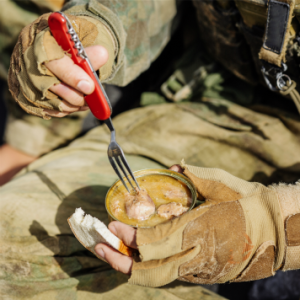
In Part 1 of our interview, we began exploring the fascinating connection between military research and the development and the foods we eat every day. Author Anastacia Marx de Salcedo gives her insight into her new book, Combat-Ready Kitchen, in part 2 of our interview.
You’ve been a food writer for years. How has your book, Combat-Ready Kitchen, changed how you think about food?
Overall, I’ve adopted a much more positive attitude about the potential for processed food. At one point I had a chapter that was titled, “How I stopped worrying and learned to love processed food.” And this is not to say that I love processed food in the way that it currently appears on our supermarket shelves, but writing this book actually gave me a lot of optimism about the possibility that we can develop foods that can be manufactured by companies and stored for longer periods of time that can still be healthy and nutritious. By that I mean, I sometimes choose these convenience foods and feel bad, because I know they aren’t as healthy as my home-cooked meals. But I would be perfectly ok if I could buy something in the store that was equivalent to homemade, and my family could still sit down and have a quick dinner around that. That’s really been a huge change for me because, like I say at the beginning of the book, I used to be a real health-food fanatic, and I thought scratch-cooking was the only way to feed your family. But I no longer think that.
Going a little further than the book, I got to thinking about what it means for women, when we are advocating a home-cooked dinner. It’s still women who do 70% of all grocery shopping, cooking, and cleaning up. So when we’re talking about making a home cooked meal, we’re really asking women to make a home-cooked meal. So I want to make sure, as a woman, that I have choices. If I feel like cooking dinner, great. But if I want to feed my family and feel good about it, I would like to have some convenient, “processed” food options that are healthy. And I think that the military actually might be part of that solution.
Could you share one way that the military has shaped our day-to-day lives not necessarily related to food, that didn’t make it into the book?
In terms of food, there are whole areas that I didn’t touch—this topic is so much bigger than what I cover in the book. Since I wasn’t going to spend 20 years writing encyclopedic tomes of thousands of pages, I had to narrow it down by thinking about the foods in a child’s lunchbox. One of the things I used to guide me was the notes from the Army Oversight Committee for food research that I got from the National Academy of Sciences in Washington. I had those notes dating back to when the committee was first created at the end of World War II. In those notes I could see references to a huge number of projects that I didn’t pursue. Chemistry of flavor is one—the Army actually did a lot of work on flavor and texture and figuring out how to preserve them. I also didn’t look into some work on plastic packaging and microbiology research.
Outside of the food arena, this whole idea of military preparedness is in every single area of research and development that the government funds. The Department of Defense (DoD) has 80 different federal laboratories, and there are 700 for the entire federal government. This process is going on in pretty much every sector. One fun thing I do every morning is read ScienceDaily, and they have these little science snippets. It’s kind of an optimistic way to start the day. I go through that in the morning, and I can sniff out when there is DoD influence in some of this research. Just today I found one—the news was about a small plastic patch that can be printed and stuck on somebody’s arm to monitor his or her vital signs. I looked at that, and I knew it had to be Army funding—and there it was, sure enough. The primary funder was the DoD. So these things are happening in medicine, in automotive, in construction materials, video gaming—the list is infinite.
Another influence that parents might be interested in is that the DoD did research and found a new material that will be used to protect soldiers during blasts and explosions. This material will be used in football helmets and bicycle helmets. The list just goes on and on. The DoD is the biggest funder of science and technology development in the federal government, followed by the NIH. Anything that the military funds will have that war functionality, but it may end up benefiting consumers. It’s fascinating.
Many people want our food to be healthier and more sustainable. Is there any way to work with the military so that their research and development is aligned with these civilian interests? Or do you think maybe it already is somehow aligned?
I don’t think it is aligned. But I absolutely think that military needs and consumer needs could be better aligned, and I advocate for that at the end of the book. So I can see that happening in a couple different ways. One way is awareness; more people will become aware of this connection and start thinking about it. Another way is through the oversight committee for army food research. Until the 1980s, that research committee was actually an outside committee made up of scientists and representatives from industry as well as from the military. Right now, it’s solely composed of military members, but I think it would be a really good thing to have some consumer representatives on that committee. That way they could think about possible implications for long-term human health and environmental sustainability.
The other thing that consumers could do is actually propose cooperative research projects. The military works on projects with universities and industry, and I see no reason why some groups that were interested in creating new, healthier food products couldn’t be involved in some of these projects.
The military has helped develop processed food products that many would argue are now contributing to childhood obesity, leaving many young adults unfit to serve. Do you think the military specifically recognizes this problem and will work on solutions?
The Military has definitely had a problem with men and women not meeting the physical standards needed to serve, so this issue is on their radar. I don’t think that they have framed it in terms of “we’ve contributed to this problem by inventing some of the food science and technology that goes into the consumer foods that make people obese.” However, I know that they are interested in improving soldiers’ health and improving the health of the applicant pool for new recruits so I think that they would certainly be open to it.
What are some things you’d like to see the military research and develop that could help the American diet?
I think there is a huge area now where you can start to work on foods that have a little longer shelf-life — not necessarily the military requirement of 3 years and 80 degrees — foods that could be equivalent to fresh food in terms of their healthfulness and lack of additives. Like I said in Part 1 of the interview, I think High Pressure Processing appears to be a method that could truly add to this small but growing group of food items that are sort of processed but still pretty fresh and healthy. The bagged salad greens packed with specific gasses to keep them fresh would be in that same category. I do think that by working with the military we could get to a place where we would go to the supermarket and buy, for the same amount of money or a little bit more, foods that taste good and last longer but don’t compromise on nutrition.
One other area that the military could do more work on is to figure out some alternatives to synthetic polymers. We should develop biopolymers and materials that don’t have harmful impacts on the human body when parts of them migrate out of the material or when they break down. It’s necessary, especially in light of the current research linking BPA with obesity and diabetes. I think it’s really important that we think about some of the packaging. The military would be a great place to start because they are very interested in this issue.
Read and excerpt from Combat-Ready Kitchen: How the U.S. Military Shapes the Way You Eat.












